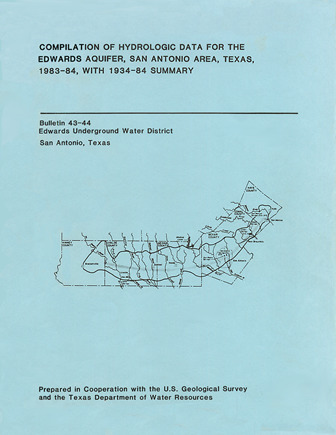1983-84 Hydrologic Data Report – Compilation of Hydrologic Data for the Edwards Aquifer, San Antonio Area, Texas, 1983-84, with 1934-84 Summary

| Author | Reeves RD and Ozuna GB (US Geological Survey) |
| Year | 1986 |
| Description | Annual report for 1983-84 on recharge, discharge, water levels and water quality in the Edwards Aquifer San Antonio Region |
| Report Number | Bulletin 43-44 |
| Publisher | Edwards Underground Water District |
| Location | Edwards Aquifer - San Antonio Area |
| Cover | View Download |
| File | View Download |
| Summary |
|
The average annual ground-water recharge to the Edwards aquifer in the San Antonio area, Texas, for 1934-83 and 1934-84, was 604,700 and 596,700 acre-feet, respectively. Annual recharge for 1983 and 1984 was significantly below the average annual recharge. The recharge in 1983 was 420,100 acre-feet. Recharge in 1984 was 197,900 acre-feet, which is the ninth lowest estimated annual recharge since 1934. A maximum annual recharge of 1,711,200 acre-feet occurred in 1958, and a minimum annual recharge of 43,700 acre-feet occurred in 1956. The calculated annual discharge by wells and springs in 1983 and 1984 was 720,100 and 702,300 acre-feet, respectively. Annual discharge by wells and springs ranged from a maximum of 960,900 acre-feet in 1977 to a minimum of 388,800 acre-feet in 1955. The annual discharge by wells was 418,600 acre-feet in 1983. In 1984, the annual discharge by wells was 529,800 acre-feet, which is a record high for the 1934-84 period of record. Although water levels in many of the wells fluctuated near or below the midpoint between record high and low level s in 1983, the volume of ground water in storage in the aquifer was above average during most of the year. In 1984, substantial declines occurred during the spring and summer, and water levels then fluctuated below average conditions in most of the wells. Water levels in many of the wells fluctuated just above the 1956 record low during the summer. The volume in storage in the aquifer was below average during most of 1984. Analyses of water samples from 158 wells and 3 springs in the Edwards aquifer show that the water in the freshwater zone is of a significantly better quality than the level established for public water systems. However, 62 percent of samples from 77 wells and 3 springs contained 1 or more organic compounds. Analyses of water samples collected from six wells in Bexar and Uvalde Counties showed concentrations of tetrachloroethylene in excess of 5 micrograms per liter. In 1984, samples were collected from wells along the “bad-water” line to detect changes in water quality as the potentiometric head in the |
Search for Documents
Advance Search
Explore EAA's Scientific Reports
- All Reports
- Geomorphology and Caves
- Weather Modification
- Geology
- Water Use and Conservation
- Geochemistry
- Water Resources Planning and Management
- Floods and Drought
- Water Quality
- Climatology
- Surface Water / Groundwater Relationship
- Biology
- Springs, Groundwater Discharge
- Archaeology
- RZ Protection
- Aquifer Levels
- Remote Sensing
- Precipitation
- Overview Studies
- Modeling
- Hydrology and Hydrogeology
- History
- Groundwater Recharge, Recharge Zone
- Groundwater Movement
